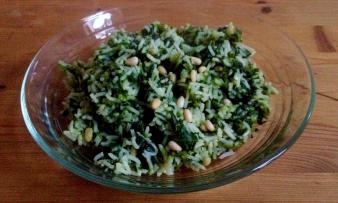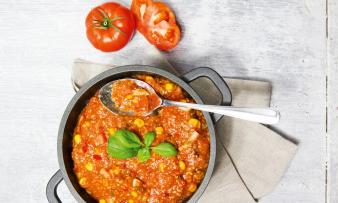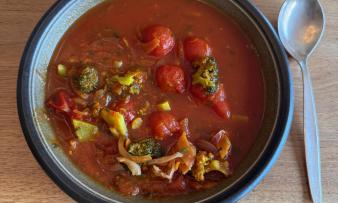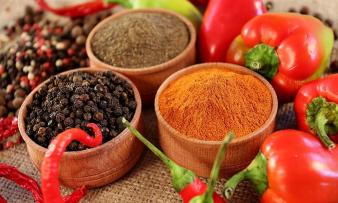Carotenoids (carotenoids)
Carotenoids give fruits and vegetables their vibrant colors and offer numerous health benefits, including a reduced risk of cancer. Learn what you can do for your health in our article.
General
Plants produce bioactive compounds with beneficial properties for humans in the context of primary and secondary metabolic processes. Carotenoids are abundant in various plant foods. They play a fundamental role in biological, chemical and physiological life processes.
The articles Nutrients comprehensively explained, Secondary plant substances and Vegans often eat unhealthily provide an overview of the classification of various groups of substances, their occurrence in certain plants and foods, and possible positive health effects on humans - enriched with valuable information on avoidable nutritional errors for a comprehensively healthy diet.
Basics
Carotenoids are among the oldest known molecules and are a very extensive group of secondary plant substances. They emerged around three billion years ago and initially acted in cell membranes as cell-strengthening, long, barely twistable and malleable lipid molecule chains. In the course of evolution, carotenoids developed additional photosynthetic, light-protective and aromatic functions in organisms in addition to their structural function. 11
Science discovered carotenoids around 200 years ago in the pigments of carrot roots. Currently, interdisciplinary scientific studies are focusing primarily on the diverse health-promoting effects of carotenoids on various chronic diseases. The best known is probably the ability of certain carotenes, such as β-carotene, to be converted into vitamin A in the body. Vitamin A is essential for vision, growth, function and structure of tissues, blood, bones, metabolism and reproduction. 4,9,11
Chemical properties and biosynthesis
Carotenoids belong to the tetraterpenes. They consist of eight repeated isoprene units with cyclic or linear structures at both ends of the carbon chains. Their respective color character is based on a system of numerous conjugated double bonds. Carotenoids are chemically unstable and tend to oxidize in the presence of light, heat, oxygen, acids and metal ions. They are also insoluble in water. As important lipochromes, however, they dissolve in fats (i.e. are fat-soluble or lipophilic) and usually associate with fats (lipids) in the organism. 4,5,11
Carotenoids are divided into the oxygen-free carotenes (e.g. α-carotene, β-carotene, γ-carotene and lycopene) and the oxygen-enriched oxycarotenoids. The latter are better known under the name xanthophylls (e.g. fucoxanthin, lutein and violaxanthin). Xanthophylls form alcohols, aldehydes, ketones and carboxylic acids. Carotenes are highly soluble in organic solvents (e.g. ether and hexane) and insoluble in polar solvents (e.g. alcohols). The opposite is true for xanthophylls. 4,5,11
The biosynthesis of carotenoids takes place through various complex, interwoven processes in the chloroplasts. Various chemical processes (catalysis, condensation, transformation) form lycopene from fatty acids. Lycopene (lycopene) can be converted into α-carotene and β-carotene. Carotenes produce xanthophylls, so lutein is formed from α-carotene. Carotenes are also converted into cryptoxanthin and zeaxanthin. Violaxanthin is formed from zeaxanthin. Finally, neoxanthin is formed from violaxanthin. These chemical transformations are reflected in the natural ripening and coloring processes 4 (see also the next chapter).
Functions in plants
Carotenoids absorb light in a broad spectrum, mainly in the blue wavelength range, and transfer the light energy to chlorophyll for use in photosynthesis to initiate the photochemical processes of photosynthesis. Carotenoids are stored in the membrane proteins of chloroplasts, chromoplasts, amyloplasts (starch storage plastids) and elaioplasts (lipid storage plastids). In fruits, flowers and roots, carotenoids are found in the chromoplasts, while in seeds they are stored in the amyloplasts or elaioplasts. Xanthophylls are found freely in green plant tissues, and in fruits and flowers they occur as esters of fatty acids. 5,11
Chromoplasts (from the ancient Greek "chroma" = color) often develop from chloroplasts. The transformation begins as soon as the initially green flowers and fruits ripen. The chlorophyll disappears, the fine structure changes and carotenoids and fats accumulate in fine droplets. Something similar happens with the autumn coloring of the leaves: the chlorophyll breaks down, the carotenoids remain and determine the pigmentation. In addition, carotenoids are also bound to proteins or sugar as water-soluble derivatives in cell spaces (vacuoles). In bound form, carotenoids are more stable than when they are exposed to light, air and oxidants. Carotenoids are vital for the leaf organ in all plants, while only some plant species have carotenoids in the petals. 5,11
The main functions of carotenoids include: 11.8
- Support of the photosynthesis process (as light-absorbing pigments in the photosynthesis complex, which expand the absorption spectrum of chlorophyll types a and b)
- Absorption of excess light energy and dissipation through heat
- UV-protective effect against cell damage
- Binding of free radicals (antioxidant properties)
- Membrane stabilization and plant growth
- Attracting pollinating insects with colour pigments
- Colour pigments in animals (including bird feathers, milk, fish scales, crustaceans)
- Protection of the retina of the eyes through blue light filter effect
- Intercellular communication through the formation of connexin proteins
- Stimulation of the immune system and cognitive functions
Occurrence in food
Carotenoids are the second most common pigment found in nature after chlorophyll. However, they are present in all organisms through the food chain. Science has so far identified about 750 carotenoids, 18 of which have been detected in the human organism 11 (the cited source is from 2021). α-carotene, β-carotene, γ-carotene, lycopene, β-cryptoxanthin, lutein and zeaxanthin are the most common. Carotenoids present in animal and human organisms basically come from plant food sources (such as herbs, fruits, grains and vegetables) or from synthetic sources (e.g. food coloring). γ-carotene is the main carotene in all green plants and cyanobacteria. However, aphids, spider mites, certain archaea, bacteria and fungi can also produce carotenes - for example, green bacteria produce γ-carotene and purple bacteria produce lycopene. Among the xanthophylls, lutein and fucoxanthin dominate in plants and green algae, giving brown algae and diatoms their characteristic coloring. 11
Sources of carotenoids important for humans are: 6,11
- α-carotene (yellow, orange): always in combination with β-carotene, in carrots, pumpkin, sweet potatoes, peppers and fruits such as peaches, apricots, cantaloupes, bananas
- β-carotene (yellow, orange, green): among others in Carrots, sweet potatoes, pumpkin, pepper, cabbage, spinach
- Lycopene (bright red): found in tomatoes, rose hips, watermelons, apricots, pink grapefruits, guavas
- β-Cryptoxanthin (yellow, orange): found in lemons, oranges, mangos, papayas, melons, potatoes, apples
- Lutein (dark green): in green vegetables such as broccoli, peas, Brussels sprouts, beans, spinach, purslane, kale, watercress, parsley andlettuce
- Zeaxanthin (orange-yellow): found in corn, marigold flowers, oranges, peppers, goji berries and sea buckthorn
- Violaxanthin (brown-yellow), capsanthin (orange), capsorubin (orange-red): in pansy, dandelion, narcissus blossom, paprika ,pepper, among others
In most fruits and vegetables, β-carotene generally predominates over its geometric isomer α-carotene. Significantly high levels of α-carotene are found in a limited number of fruits and vegetables, such as bananas, sweet potatoes, carrots, pumpkins, and dark green vegetables (such as green beans, spinach, and broccoli). 1,4 Since α-carotene is converted to lutein, lutein (almost 45%) and β-carotene (25–30%), followed by violaxanthin (10–15%) and neoxanthin (10–15%), are the predominant forms of carotenoids in green leafy vegetables. 11
Carotenoids such as lutein, zeaxanthin and cryptoxanthin as well as α-carotene and β-carotene have been detected in cereals, with the total carotenoid content in corn being significantly higher than in oats, wheat or barley . In most types of wheat, lutein accounts for more than 85% of the total carotenoid concentration. 1
Neoxanthin (yellow) is a natural component of vegetable leaves. Bixin is the main component of the spice or dye annatto and is responsible for the reddish-brown color. Crocin colors saffron yellow. Some carotenoids are only found in algae and seafood. For example, astaxanthin occurs naturally in microalgae of the species Haematococcus pluvialis and as a metabolic product in krill 16. This carotenoid causes the typical coloring of shrimp, salmon and flamingo feathers via ingestion (food chain). 4
Information on the amounts of carotenoids present in various plant-based foods can be found in the nutrient comparisons for the ingredients . Guidelines for classifying plant-based foods based on their carotenoid content are divided into the following categories: low content (0–100 μg/100g), moderate content (100–500 μg/100g), high content (500–2000 μg/100g) and very high content (>2000 μg/100g). 1,4 In the table mentioned (nutrient comparisons for ingredients), many fresh and sometimes dried herbs (such as parsley, basil, coriander, etc.) are shown as foods very rich in carotenoids. This has been confirmed by some studies 13,14 (including for fresh dill and chervil 15 ); however, according to our information, such research is rather rare.
Various factors - such as variety, genotype and maturity stage, as well as harvest time, growing conditions, post-harvest treatment, handling, storage conditions, plant diseases and climatic conditions - influence the composition and content of carotenoids in foods. Different parts of the same plant may also contain different types and amounts of carotenoids: for example, the skin of fruits is generally richer in carotenoids than the flesh. 4
Absorption in the human organism and bioavailability
Of the approximately 750 known carotenoids, the human organism absorbs and metabolizes around 40 to 50. Chewing food and the action of enzymes in the digestive process release carotenoids from the food. This serves to store carotenoids in micelles. Micelles are lipids arranged in a spherical shape in water. Bile salts enable the formation of micelles by helping to break down lipids. This leads to the digestion and absorption of food substances such as carotenoids. Lipases are enzymes that support this process by breaking down lipids into smaller molecules. 9
The conversion of β-carotene to vitamin A takes place in the cells of the small intestine wall. Excess carotenoids reach other tissues via the bloodstream, such as fatty tissue, skin and subcutaneous tissue (carotene and xanthophyll reserves), corpus luteum in the retina (lutein, zeaxanthin and mesozeaxanthin), pancreas and vascular endothelium. 9
The texture of food has a strong impact on the bioavailability of carotenoids. Studies report that the bioavailability of β-carotene in raw foods is rather low because carotenoids are bound to protein complexes, fibers, and cell walls, making them resistant to digestion and degradation and limiting their release. 4 Soluble fiber may limit the bioavailability of carotenoids by affecting the viscosity of gastrointestinal contents, the size of lipid droplets, the availability of bile salts, and the enzymatic lipolysis of triglycerides.
According to several studies, bioavailability can be improved by simultaneously supplying minerals, reducing fiber, releasing cell contents, softening plant material and reducing interactions between carotenoids and other food components. 3,4,6 This means that careful preparation or the way of consumption can noticeably increase the absorption of carotenoids. Factors such as cutting, cooking or adding fat have been shown to increase their accessibility and thus their absorption. 17 Cutting plays the biggest role here. 17,18
Although fat increases the absorption of carotenoids from food, it is much more efficient to break the food down (chew it well, puree it, etc.). Cooking helps to destabilize the cell walls and thus also contributes to availability; however, it also destroys heat-sensitive ingredients such as many B vitamins or vitamin C. 18,20
When it comes to fat intake, natural fats such as nuts ( macadamia, walnuts, etc.) or avocado are sufficient. 18,19 You should avoid additional oil or even butter, as they do not achieve better results in terms of bioavailability and do more harm than good . However, numerous scientific publications ignore these facts and only focus on the topic of oil: Studies underline that the plasma concentrations of lycopene and zeaxanthin increase when carotenoids are consumed with vegetable oils ( safflower oil ) as a carrier substance. Similarly, a study showed the effect of soybean oil on the absorption and bioavailability of carotenoids from spinach, lettuce, carrots and tomatoes. The plasma concentrations of α-carotene, β-carotene, lutein and lycopene increased with increasing concentration of soybean oil. 4
Packaging and processing methods (such as thermal treatment and various drying processes) significantly degrade the carotenoid content. For most vegetables, drying reduces the carotenoid content by 10-20%, pulverization results in further losses - as well as auto-oxidation, high temperatures, light and air. Thermal processing leads to their degradation due to possible trans -to- cis isomerization of β-carotene and lutein. This was observed in a number of studies on fruits and vegetables such as peas, broccoli, kale, spinach and corn. 4,7
Although heat treatment reduces carotenoid content, the concentration of some carotenoids increases with heating (e.g. lycopene) because the structures of protein-carotenoid complexes change. Studies show that lutein and β-carotene contents in various vegetables tend to increase with cooking and decrease with steaming. Violaxanthin and neoxanthin contents are reduced slightly less by cooking than by steaming. Further studies are needed to investigate the nature of the various carotenoids during thermal treatments. 2,3,4
Climatic and geographical components also influence carotenoid content. Studies suggest that fruits exposed to high temperatures and higher levels of sunlight enhance carotenoid biosynthesis to protect the plant from photooxidation. 4
Food supplements and additives
The production of β-carotene and most other carotenoids is now relatively cheap. The food industry uses some carotenoids (E160) to color and prepare foods, soft drinks, juices, butter, preserves, jam and baked goods; violaxanthin and astaxanthin (E161j) are also used as an additive in animal feed, and lutein (E161b) and canthaxanthin (E161g, e.g. from chanterelles) are used to color the meat of farmed salmon or to improve the color of egg yolks.
The food additive beta-carotene (E160a) is obtained from carrots, while annatto (synonym: bixin, norbixin, E160b) comes from the annatto bush ( Bixa orellana - from Peru/Brazil, i.e. Neotropics). 6,9 The carotenoid lycopene (E160d, syn.: lycopene, leucopene) is found in high concentrations in tomatoes and rose hips, zeaxanthin (E161h) is often produced synthetically or extracted from zeaxanthin-rich plant parts and algae, including the petals of marigolds and marigolds ( Tagetes L.).
Other carotenes used are α-, β- and γ-carotene and capsanthin (E160c, the main carotenoid of red peppers, as well as capsorubin). But also xanthophylls such as flavoxanthin (approved as E161a until 1994, e.g. from dandelion blossom), cryptoxanthin (e.g. from oranges), rubixanthin (approved as E161d until 1994, e.g. from rose hips) and rodoxanthin (approved as E161f until 1994).
In pharmaceutical technology, carotenes are used to color dragees, capsules, suppositories, ointments and emulsions. In medical treatments, pure β-carotene acts as a drug for the systemic treatment of skin diseases, as an adjunct to the administration of phototoxic drugs and to prevent chronic photodamage, tissue changes and tumors. Canthaxanthin is found in tanning products. 6,9
However, the use of carotenoids in the food industry is limited due to their low water solubility, bioavailability and rapid release. Encapsulation processes improve the stability, solubility and bioavailability of carotenoids. The food industry has been using this technique for more than 60 years to package food ingredients, enzymes, cells or other functional compounds in small capsules; with the aim of protecting them from environmental influences, extending their shelf life or masking properties of components such as undesirable flavors. 4
Overdose can lead to hypercarotenemia (yellowing of the skin), which is reversible by stopping carotene intake. It is possible that the intake of β-carotene by smokers with a history of myocardial infarction increases the risk of fatal heart disease. However, β-carotene is considered to be a largely harmless substance. 4,5
Health effects
Research has widely confirmed the numerous positive health properties of carotenoids, such as their antioxidant, antitumor, antidiabetic, anti-aging and anti-inflammatory effects. The effects of provitamin A carotenoids are particularly valued. Around 50 of the approximately 750 known carotenoids are split into substances with provitamin A properties such as α-, β- and γ-carotene and β-cryptoxanthin. Others are sapotexanthin, cryptocapsin and β-apo-8'-carotenal (beta-apo-8'-carotenal). Only carotenoids with a β-ion ring, which is not present in carotenoids such as lycopene, lutein and zeaxanthin, have provitamin A activity. 4
Vitamin A exists as retinal, retinol and retinoic acid. The vitamin is essential for maintaining vision, modulating gene expression, promoting embryonic development and reproduction, cell growth and differentiation, strengthening the immune system, stimulating metabolic processes in the gastrointestinal tract and reducing the risk of cancer. 4
The antioxidant properties of all carotenoids, especially β-carotenes, α-carotenes, zeaxanthin, β-cryptoxanthin, canthaxanthin, astaxanthin, lutein and lycopene, are worth highlighting. As antioxidants, they slow down, inhibit or prevent the oxidation of molecules and protect cells, tissues and organs from damage caused by free radicals. Lycopene is particularly effective against and protects against oxidative stress due to its long-chain double bonds. 1,4 The highest concentrations of lycopene in humans are found in the adrenal glands, liver, testes and prostate. Tumors must create new blood vessels from existing ones (angiogenesis; this is important for the vascularization and growth of tumors). Lycopene hinders this process to such an extent that it is considered a promising research object in the service of cancer therapy. 12
Carotenoids activate certain genes that control the production of a protein (connexin), which is part of cell communication structures. Cells use these connections to exchange signals and messenger substances to regulate cell growth. In cancer cells, this signal exchange no longer takes place. The presence of α- and β-carotene, zeaxanthin, lutein or lycopene suppresses the conversion of previously damaged cells into cancer cells. The anti-inflammatory properties of these carotenoids thus have a positive influence on carcinogenesis. Carotenoid intake or carotenoid concentration in the blood show positive effects on cancer of the lung, prostate, esophagus, cervix, ovary, breast, stomach and colon. Studies have also found positive synergies between carotenoids and phenolic compounds through an improved antioxidant effect in organisms. 1,5,9
However, the results of various intervention studies with β-carotene suggest that these relationships are not necessarily causal. It is possible that β-carotene should be seen as an indicator of a diet rich in fruit and vegetables, which has a cancer-preventive effect due to its content of secondary plant substances, vitamins and minerals. There is also similar evidence for α-carotene, lutein, lycopene, zeaxanthin and β-cryptoxanthin. Sufficient consumption of carotenoids could be associated with a lower risk of heart, bone, skin and eye diseases. 1,9
When it comes to modifying carotenoids to treat diabetes, the mechanism of action is still unclear, but the antioxidant effect plays a central role, among other processes. Diets rich in carotenoids reduce the risk of knee osteoarthritis, osteoporosis, arthritis and stimulate bone growth. Comprehensive studies demonstrate the preventive effect of lycopene on cardiovascular diseases. Clinical studies show that lycopene lowers total cholesterol levels. Recent studies demonstrate the role of carotenoids as immune regulators in the form of therapeutics for viral infections such as COVID-19 and HIV. However, further studies are needed to confirm this. 1,4,8
There is controversy as to whether secondary plant substances, including most carotenoids, that are synthesized or removed from the plant also have health effects. In any case, carotenoids are excellent biomarkers due to their great structural diversity and distribution. For example, studies record the daily intake of vegetables by measuring the amount of carotenoids in the blood or in excretion products. 4
Summary
Carotenoids are of fundamental importance for plants and fulfil a wide range of functions in photosynthesis, light protection, colouring, phytohormone synthesis and signal transmission. Carotenoids also offer numerous health-promoting potential for humans as secondary plant substances and are crucial as precursors of vitamin A synthesis and as antioxidants in food. They help significantly to reduce oxidative stress and the risk of various diseases. Carotenoids are mainly found in fruit and vegetables, but are also well represented in herbs.
Despite the complex topic, in practice the following applies: Prefer a varied, plant-based and seasonally oriented diet with organic foods that are as unprocessed as possible. This way you can benefit optimally from the many positive effects of the secondary plant substances. We should eat plant-based foods as raw and unprocessed as possible or prepare them in a gentle way in order to fully exploit their nutritional potential. When it comes to carotenoids, please note our additional preparation and consumption tips for optimal bioavailability. Since the secondary plant substances are often found in the outer layers, peel vegetables and fruit carefully. If you are a vegan or omnivore, please read the article Vegans often eat unhealthily. Avoidable nutritional errors . Many of our newly edited food descriptions give you specific information about which of the substances mentioned are most prominently represented in the ingredient discussed.
Bibliography - 20 Sources (Link to the evidence)
Many researchers do not believe that Wikipedia is an authoritative source. One reason for this is that the information about literature cited and authors is often missing or unreliable. Our pictograms for nutritional values provide also information on calories (kcal).
Spinach rice with pine nuts is a very simple and quick dish to prepare with just a few ingredients that you should always have at home.
This chili with mushrooms and a sauce seasoned with wild garlic is a raw recipe that is in no way inferior to the original recipe when it comes to taste.
Erb-lycopene soup with tomatoes - read the notes to learn more about its purpose.
Dried goji berries are rich in vitamins and minerals and can be used to add variety to muesli. Organic quality?
Fresh, raw goji berries have a fruity, tart taste, are rich in vitamins and secondary plant substances and enrich a meal. Organic?
The choice of paprika varieties and the ingredients used determine the spiciness and aroma of the paprika powder. Organic, but rarely available raw.









Comments